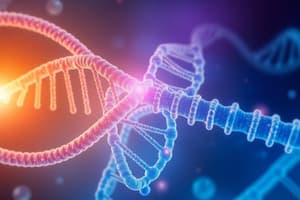Podcast
Questions and Answers
What is the first step in the process of converting genetic information from DNA to functional proteins?
What is the first step in the process of converting genetic information from DNA to functional proteins?
- RNA processing
- Translation
- Transcription (correct)
- Protein folding
Where does transcription take place in eukaryotic cells?
Where does transcription take place in eukaryotic cells?
- Endoplasmic reticulum
- Nucleus (correct)
- Cytoplasm
- Ribosomes
What is the role of transfer RNA (tRNA) in protein synthesis?
What is the role of transfer RNA (tRNA) in protein synthesis?
- Reading DNA sequence
- Transporting mRNA out of the nucleus
- Attaching amino acids to the growing polypeptide chain (correct)
- Creating mRNA copy
Which molecule carries the genetic code from the nucleus to the ribosomes for translation?
Which molecule carries the genetic code from the nucleus to the ribosomes for translation?
What is the main function of codons and anticodons in the translation process?
What is the main function of codons and anticodons in the translation process?
What is the function of an anticodon during translation?
What is the function of an anticodon during translation?
What is the role of a poly(A) tail in mRNA processing?
What is the role of a poly(A) tail in mRNA processing?
Why is the folding of a polypeptide chain important?
Why is the folding of a polypeptide chain important?
Which modification occurs at the 5' end of mRNA during post-transcriptional processing?
Which modification occurs at the 5' end of mRNA during post-transcriptional processing?
What are the sequences of three nucleotides that code for specific amino acids called?
What are the sequences of three nucleotides that code for specific amino acids called?
Flashcards are hidden until you start studying
Study Notes
DNA to Protein Process
The process of converting genetic information encoded in DNA into functional proteins is essential for life. This complex process involves several steps, including transcription, RNA processing, translation, and protein folding. Each step plays a crucial role in ensuring the correct sequence of amino acids, which is necessary for the structure and function of proteins.
Transcription
Transcription is the first step in translating genetic information from DNA to a specific type of RNA called messenger RNA (mRNA). This process occurs in the nucleus of eukaryotic cells and in the cytoplasm of prokaryotic cells. During transcription, an enzyme called RNA polymerase reads the DNA sequence and creates a complementary copy of the gene as mRNA. This mRNA strand carries the genetic code from the nucleus to the ribosomes in the cytoplasm for translation.
Translation
Once mRNA is synthesized, it is transported out of the nucleus into the cytoplasm where protein synthesis occurs. Here, ribosomes read the genetic code on the mRNA molecule and translate it into a linear sequence of amino acids called a polypeptide chain. This process requires transfer RNA (tRNA), which carries specific amino acids to the ribosome and attaches them to the growing polypeptide chain based on the mRNA code.
Codons and Anticodons
In both transcription and translation, the genetic code is essential. The genetic code specifies the sequence of nucleotides in mRNA that correspond to specific amino acids. This sequence is known as a codon, which is a sequence of three nucleotides that code for a particular amino acid. When ribosomes read the mRNA during translation, they use a complementary sequence called an anticodon, which is located on tRNA molecules. The anticodon binds to the codon on mRNA and ensures that the correct amino acid is added to the polypeptide chain.
mRNA Processing
After transcription, mRNA undergoes several post-transcriptional modifications to become functional for translation. These modifications include the addition of a 7-methylguanosine cap at the 5' end and a poly(A) tail at the 3' end. These modifications help protect the mRNA from degradation, stabilize the mRNA, and facilitate its transport to the ribosomes for translation.
Protein Synthesis
The final step in the DNA to protein process is protein synthesis, where the polypeptide chain is folded into a specific three-dimensional structure. This folding is critical for the function of the protein. Some proteins require additional modifications, such as the addition of functional groups or the attachment of other molecules, before they can perform their specific functions.
In summary, the DNA to protein process is a highly regulated and complex series of events that occurs in all living organisms. From transcription to translation and mRNA processing, each step ensures that the correct sequence of amino acids is created, leading to the formation of functional proteins.
Studying That Suits You
Use AI to generate personalized quizzes and flashcards to suit your learning preferences.



